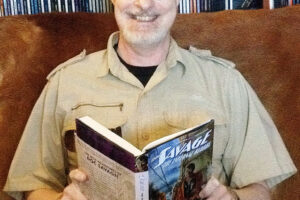
In 1937, Harold Brainerd Hersey published “Pulpwood Editor: The Fabulous World of the Thriller Magazines Revealed by a Veteran Editor and Publisher,” a personal look back at the pulp magazine industry.
Hersey broke into the pulps with Street & Smith after World War I. In 1919, at age 26, he was editing the short-lived (and highly collectible) pulp The Thrill Book. From Street, Hersey moved to the Clayton and Macfadden chains before starting his own pulp publishing companies, Magazine Publishers and Good Story Magazine Co.
As part of the promotion for the book (which was reprinted by Adventure House in 2002), Hersey talked with May Cameron of the New York Post for an article published Saturday, June 5, 1937. I thought I would share his comments.
On the pulp story:
Don’t forget that a pulp story is action, action, action — a continuous series of thrilling action situations until one grand and glorious situation ends the story. And be sure that the person, the hero or heroine of your story, is doing something exciting when your story opens. Don’t stop to describe scenery or local color, suggest it. Place this person immediately in jeopardy. And from then on let this person have ants in his pants. That’s a pulp story.
On the love-story pulps:
For the love-story pulps the formula still holds good. Take (the most adventurous person you know) and place her in an exciting situation — a house afire, a theatre burning or a subway accident. There you have the “girl meets boy.” There is a misunderstanding and they part. Lay on the sentimentality and indulge in self-pity; the pulps do it. But don’t stretch the long arm of coincidence. Once in a while, if a story is exceptionally well written, girl loses boy and in the last paragraph you have something like: “Was it tears or was it rain?” Usually, however, girl gets boy and it’s a happy ending. Okay, why not?
On imitations:
Street and Smith, the greatest pulpwood publishers ever, brought out Western Story and then Harold Hersey, the louse, brought out Outlaws of the West and then you had imitations of the imitation. Pretty soon you have 10 or 15 magazines of the same kind. But it is an old law of the pulpwood that the original always lasts. Imitations fold up, but you never kill off this original.
On radio and books:
That’s where the big money is. Keep your radio on 12 hours and listen to the fiction. You’ll find the radio has imitated the pulp magazine in its fiction formula. The radio audience and the pulp-magazine audience are pretty much the same and if writing for the pulps teaches you to write for radio, it’s the best school of writing in the world.
This, however, is a tough one and hard to explain. Pulp writing is not a preamble to book writing. There is something about the pulpwood world that is non-literary. Writing blood and thunder plots is apt to leave the writer weak on characterization, which seems to me the heart of a novel. Neither does pulp writing create the careful state of mind that seems to me necessary to the writing of books.
Of course, within 20 years radio would be eclipsed by a new popular medium, television. And pulp fictioneers would be flocking to write westerns, detective and other pulp-like scripts for it.
A tip of the slouch hat to David Lee Smith, admin on the Pulp Magazines group at Yahoo Groups, for posting a few vintage newspaper articles, which got me looking through old newspapers.


